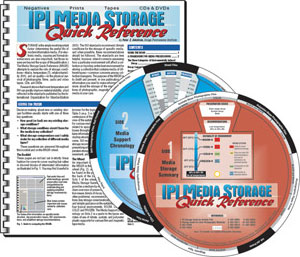Good Storage Practices
 |
|
The IPI Media Storage Quick Reference shows how temperature affects the long-term stability of mixed-media collections.
|
Identifying the nature of film materials. Nitrate, acetate, and color materials require cold storage for long-term storage.
Assessing conditions helps organize preservation priorities and develop best-fit storage practices. The more advanced the decay of acetate film collections, the colder the storage should be.
Storing film under proper environmental conditions prolongs film life.
The best storage for motion picture film includes cold storage and moderate humidity conditions and good-quality storage enclosures. Metal or plastic cans are safe for film, provided that the containers are not rusty or broken. Archival-quality cardboard boxes are also safe. If film is kept at or near room temperature, do not seal film inside tightly closed bags. At all costs, avoid storing film in prolonged dampness. Under damp conditions, the film will stick together and mold may grow, ruining the emulsion. Damp locations such as basements or attic areas are particularly unsuitable for film storage.
A relative humidity (RH) of 20 to 50% is best for film storage, with a temperature that is as cold as possible. Use the free IPI Preservation Calculator to evaluate your current storage conditions.
More Information
Peter Z. Adelstein. IPI Media Storage Quick Reference. 2nd ed. Rochester, NY: Image Permanence Institute, Rochester Institute of Technology, 2009). See also IPI’s website FilmCare.org.
